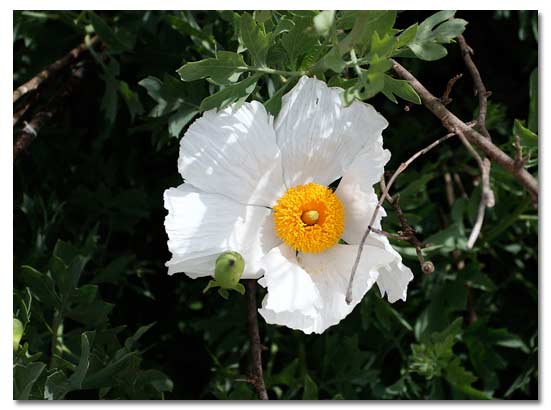Prickly Poppies
Argemone pleicantha

Prickly poppy is the name used for various species of the Argemone genus, all virtually indistinguishable from each other. Members of the poppy family (Papaveraceae) are characterized by flowers with numerous stamens and 4 to 6 petals.
This very branchy, pale green plant grows to 4 feet high and is covered with yellow pricklies. Long, very lobed, spiny leaves resembling thistles grow to 8 inches. All parts of this plant contain alkaloids that are poisonous. It is common throughout the West because not even cattle eat it.
Genus: Argemone
Range
Throughout the Southwest deserts from California east to Texas and to northern Nevada and Utah.
- Sonoran Desert (A. munita and A. platyceras)
- Chihuahuan Desert (A. polyanthemos)
- Great Basin Desert (A. pleicantha)
Habitat
Sandy or gravelly desert roadsides and washes below 8,000 feet.
Flowers
White, papery flowers with a bright, single eye of yellow stamens bloom year round. Flowers grow to 3 inches wide and have 6 broad, delicate, wrinkled petals.
Prickly poppies are also called
- Thistle Poppy
- Chicalote
- Cowboy's Fried Egg

Argemone platyceras
We have an online wildflower field guide that is designed to help you identify desert wildflowers by color, scientific name, region and common name. The pictures are sized to work on the iPod, iPhone, iPad and similar devices. With your iPod or phone you will easily be able to identify wildflowers while in the desert. Links for downloads are on the bottom of the Wildflower Field Guide page.
Photo tips: Most digital point-and-shoot cameras have a macro function - usually symbolized by the icon of a little flower. When you turn on that function, you allow your camera to get closer to the subject, looking into a flower for example. Or getting up close and personal with a bug. More on desert photography.
Mojave Desert Wildflowers - This book is the standard by which all other wildflower books are measured. The author, Jon Mark Stewart, has combined super photography with concise information. This book has an entire color page for each wildflower covered, with a discussion of the wildflower. 210 pages with 200 color photos. More...
What's Blooming Now - Check the Wildflower Reports
Related DesertUSA Pages
- How to Turn Your Smartphone into a Survival Tool
- 26 Tips for Surviving in the Desert
- Death by GPS
- 7 Smartphone Apps to Improve Your Camping Experience
- Maps Parks and More
- Desert Survival Skills
- How to Keep Ice Cold in the Desert
- Desert Rocks, Minerals & Geology Index
- Preparing an Emergency Survival Kit
Share this page on Facebook:
The Desert Environment
The North American Deserts
Desert Geological Terms



